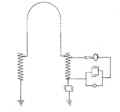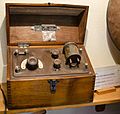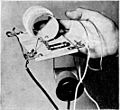Crystal radio facts for kids
A crystal radio, sometimes called a crystal set, is a very simple AM radio receiver, that does not need batteries to work. A long wire antenna gathers enough of the radio signals from nearby transmitters to power a crystal diode, which demodulates the signals, and plays them as sound through an earphone or small headset.
Crystal radios have come and gone many times in history. They were built in the early days of radio broadcasting by amateurs, and people who could not afford a well-made radio. They became popular again during the Great Depression, when money was scarce. During World War II, American soldiers built "foxhole radios" that used a razor blade and pencil point instead of a crystal. (German and Italian troops had equipment to detect normal superheterodyne radio receivers working, so an alternate choice was a wise one.)
After the war ended, amateurs built more crystal sets, and children began to make them as science and hobby projects. Later during the Vietnam War prisoners of war again built simple radios, and soldiers used Slinky springs as antennas.
Hobby clubs still exist, that give information to persons who want to build a crystal radio or similar radio project.
Images for kids
-
US Bureau of Standards 1922 Circular 120 "A simple homemade radio receiving outfit" taught Americans how to build a crystal radio.
-
Crystal radio (1915) kept at the Museum of the radio - Monteceneri (Switzerland)
-
Pictorial diagram from 1922 showing the circuit of a crystal radio. This common circuit did not use a tuning capacitor, but used the capacitance of the antenna to form the tuned circuit with the coil. The detector was a cat whisker detector, consisting of a piece of galena with a thin wire in contact with it on a part of the crystal, making a diode contact
-
Germanium diode used in modern crystal radios (about 3 mm long)
See also
 In Spanish: Radio de galena para niños
In Spanish: Radio de galena para niños
















